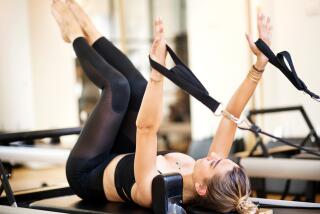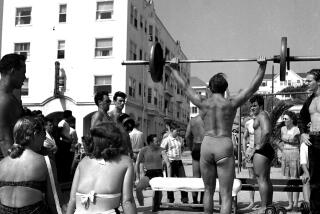Vary Your Routine to Get Past Those Fitness Plateaus
- Share via
At first the results come quickly.
“When people start working out, they’ll see dramatic changes in the first six weeks to three months,” says Douglas Brooks, an exercise physiologist and personal trainer in Mammoth Lakes, Calif. “But the reality is that once your body gets accustomed to your routine, you’re going to get diminishing returns for the time and muscle spent.”
Many people get discouraged by these workout plateaus, which often become “dropout” zones for novices who haven’t made exercise a habit. One key to pushing past the plateau, Brooks says, is to change your routine.
“Humans improve physically by the overload principle,” he says. “This means we adapt to a new stimulus by getting stronger. But once the stimulus is no longer new and the body becomes efficient at doing that activity, improvement levels off.” Since most people adapt to a physical routine in about six weeks, he says, that’s a good time to change your workout.
*
Top trainers list numerous ways to throw your body a curve. You can try a new activity--such as in-line skating, kick boxing or swimming--and alternate it with your primary form of exercise. By alternating activities, you work different muscle groups in different ways to achieve better results and more well-rounded fitness while reducing your risk of injury and boredom.
You can also stick with one activity, but do it in different ways. For example, if you walk daily, take a new route, add some hills or try faster-paced intervals. Adding motivational music, enlisting the help of a coach or trainer or exercising with a buddy all can help push you past a fitness plateau.
“The point is to get out of the rut of always doing the ‘same old, same old,’ ” says John Philbin, president of the National Strength Professionals Assn., a Germantown, Md.-based organization that trains and certifies fitness professionals.
Altering the order in which you do exercises, switching to new exercises or using different forms of resistance (for example, free weights instead of strength-training machines) can all challenge the body in new ways and boost results, says Philbin, who is also assistant strength coach for the NFL’s Washington Redskins. “We have six to 10 different workouts for the football players,” he says. “Just about every time they train it’s different.”
To maximize strength training results, it’s important to use a weight that’s heavy enough to work your muscles to fatigue. Once you’re able to do 15 repetitions with a weight for three sessions in a row, Philbin advises moving up to a weight that’s 3% to 5% heavier.
When you’re unable to lift heavier weights with good form, you’ve probably come close to your strength potential. At that point, Philbin says, “variety becomes your best friend so you don’t get burned out or bored.”
*
Plateaus are a natural part of the training cycle and often occur because the body needs some time to adjust to physical changes, such as weight loss, says Bob Greene, the Miami exercise physiologist who coached TV host Oprah Winfrey through a marathon.
“Many people try to maintain a high level of fitness year round, but your body will need breaks,” Greene says. When people have been extremely active for a long period, he notes, “they may need to lighten up for a week so they can come back strong.”
But for most people, he says, they reach a plateau because they don’t push past their comfort zone. “The greatest mistake people make is working a notch or two below where the results are,” he says. “When you work a little harder than you’re used to working, that’s what triggers great results.”
To find this “results zone,” Greene advises paying attention to your breathing. “You should be exercising hard enough so that you’re able to talk, but you really don’t feel like talking or carrying on a consistent dialogue.” Beginning exercisers may only be able to work out at that intensity for a minute, notes Greene, who recommends gradually working up to being able to exercise in this zone for 20 to 30 minutes.
If you’re happy with your fitness level, however, it’s fine to exercise on cruise control, says Susan Kalish, executive director of the American Medical Athletic Assn. “When I run for stress reduction, I want to do the ‘same old, same old’ routine,” she says. “But when I want to run faster, I know that running with a buddy pushes me more.”
*
Active people sometimes fall into an exercise rut because they don’t update their fitness goals, Kalish says. “Your goals may have changed, but your exercise program has stayed the same,” says Kalish, whose recent switch from a young women’s soccer league to a master’s club for women over 40 helped her renew her enjoyment of the sport. “It’s helpful to reexamine your goals and consider whether what you’re doing is going to help you achieve them.”
It’s also important to set realistic goals.
“The results you can achieve are determined in part by your genetic potential,” says Sherri Kwasnicki, a Vancouver, B.C., exercise physiologist who was named the 1998 personal trainer of the year by IDEA, the world’s largest association of fitness professionals. “If all the people in your family are pear-shaped,” she says, “you have two main choices: to be an in-shape pear or an out-of-shape pear.”
Once people have been exercising regularly for a year or more, she says, “they reach what I call a happy plateau. They’ve come close to their genetic potential for fitness and can go into maintenance mode.”
Despite most people’s constant desire to improve, “not going anywhere is not always bad,” says California trainer Brooks. “Keeping yourself at a healthy fitness status and aesthetic standard for life is very positive. I’m constantly reminding my fit clients that maintenance is not regression.”
*
Carol Krucoff writes a column on health and fitness issues for the Washington Post.
More to Read
Go beyond the scoreboard
Get the latest on L.A.'s teams in the daily Sports Report newsletter.
You may occasionally receive promotional content from the Los Angeles Times.










